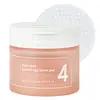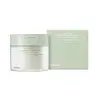What's inside
What's inside
 Key Ingredients
Key Ingredients

 Benefits
Benefits

 Concerns
Concerns

 Ingredients Side-by-side
Ingredients Side-by-side

Water
Skin ConditioningMethylpropanediol
SolventAlcohol Denat.
AntimicrobialButylene Glycol
Humectant1,2-Hexanediol
Skin ConditioningGlycerin
HumectantPanthenol
Skin ConditioningBetaine
HumectantTrehalose
HumectantGlycereth-26
HumectantPolyglyceryl-10 Laurate
Skin ConditioningAmmonium Acryloyldimethyltaurate/Vp Copolymer
Gluconolactone
Skin ConditioningSodium Citrate
BufferingSodium Hyaluronate
HumectantAllantoin
Skin ConditioningDisodium EDTA
Capryloyl Salicylic Acid
ExfoliatingPinus Palustris Leaf Extract
TonicUlmus Davidiana Root Extract
Skin ConditioningOenothera Biennis Flower Extract
AstringentPueraria Lobata Root Extract
HumectantParfum
MaskingWater, Methylpropanediol, Alcohol Denat., Butylene Glycol, 1,2-Hexanediol, Glycerin, Panthenol, Betaine, Trehalose, Glycereth-26, Polyglyceryl-10 Laurate, Ammonium Acryloyldimethyltaurate/Vp Copolymer, Gluconolactone, Sodium Citrate, Sodium Hyaluronate, Allantoin, Disodium EDTA, Capryloyl Salicylic Acid, Pinus Palustris Leaf Extract, Ulmus Davidiana Root Extract, Oenothera Biennis Flower Extract, Pueraria Lobata Root Extract, Parfum
Water
Skin ConditioningButylene Glycol
HumectantAlcohol Denat.
AntimicrobialCamellia Japonica Flower Extract
Emollient1,2-Hexanediol
Skin ConditioningArginine
MaskingSalicylic Acid
MaskingHydroxyacetophenone
AntioxidantC12-14 Pareth-12
EmulsifyingLactobionic Acid
BufferingEthylhexylglycerin
Skin ConditioningGlycerin
HumectantBifida Ferment Lysate
Skin ConditioningCentella Asiatica Extract
CleansingDisodium EDTA
Lactose
HumectantMelaleuca Alternifolia Leaf Oil
AntioxidantHouttuynia Cordata Extract
Skin ConditioningPortulaca Oleracea Extract
Skin ConditioningPerilla Ocymoides Seed Extract
AntioxidantPanthenol
Skin ConditioningLonicera Caprifolium Extract
AstringentPelargonium Graveolens Extract
MaskingUncaria Tomentosa Extract
Skin ConditioningAgrimonia Eupatoria Extract
AstringentCorydalis Turtschaninovii Root Extract
Skin ConditioningCupressus Sempervirens Leaf Extract
PerfumingNepeta Cataria Extract
TonicMadecassoside
AntioxidantCapryloyl Salicylic Acid
ExfoliatingWater, Butylene Glycol, Alcohol Denat., Camellia Japonica Flower Extract, 1,2-Hexanediol, Arginine, Salicylic Acid, Hydroxyacetophenone, C12-14 Pareth-12, Lactobionic Acid, Ethylhexylglycerin, Glycerin, Bifida Ferment Lysate, Centella Asiatica Extract, Disodium EDTA, Lactose, Melaleuca Alternifolia Leaf Oil, Houttuynia Cordata Extract, Portulaca Oleracea Extract, Perilla Ocymoides Seed Extract, Panthenol, Lonicera Caprifolium Extract, Pelargonium Graveolens Extract, Uncaria Tomentosa Extract, Agrimonia Eupatoria Extract, Corydalis Turtschaninovii Root Extract, Cupressus Sempervirens Leaf Extract, Nepeta Cataria Extract, Madecassoside, Capryloyl Salicylic Acid
 Reviews
Reviews

Ingredients Explained
These ingredients are found in both products.
Ingredients higher up in an ingredient list are typically present in a larger amount.
1,2-Hexanediol is a synthetic liquid and another multi-functional powerhouse.
It is a:
- Humectant, drawing moisture into the skin
- Emollient, helping to soften skin
- Solvent, dispersing and stabilizing formulas
- Preservative booster, enhancing the antimicrobial activity of other preservatives
Alcohol Denat. is an alcohol with a denaturant property. It is created by mixing ethanol with other additives.
This ingredient gets a bad rep because it is irritating and drying - mostly due to its astringent property. Astringents draw out natural oils in tissue, constricting pores and leaving your skin dried out.
However, alcohol denat. is not all that bad.
Due to its low molecular weight, alcohol denat. tends to evaporate quickly. One study on pig skin found half of applied alcohol evaporated in 10 seconds and less than 3% stayed on skin.
This also helps other ingredients become better absorbed upon application.
Studies are conflicted about whether this ingredient causes skin dehydration. One study from 2005 found adding emollients to propanol-based sanitizer decreased skin dryness and irritation. Another study found irritation only occurs if your skin is already damaged.
Small amounts of alcohol are generally tolerated by oily skin or people who live in humid environments.
The rule of thumb is if this alcohol is near the end of an ingredients list, it will probably not affect your skin much.
Also...
This ingredient has antimicrobial and solvent properties.
The antimicrobial property helps preserve products and increase their shelf life. As a solvent, it helps dissolve other ingredients.
Other types of astringent alcohols include:
Learn more about Alcohol Denat.Butylene Glycol (or BG) is used within cosmetic products for a few different reasons:
Overall, Butylene Glycol is a safe and well-rounded ingredient that works well with other ingredients.
Though this ingredient works well with most skin types, some people with sensitive skin may experience a reaction such as allergic rashes, closed comedones, or itchiness.
Learn more about Butylene GlycolCapryloyl Salicylic Acid comes from salicylic acid, the famous acne-fighting BHA.
It usually goes by a more common name of LHA, or lipohydroxy acid.
Like salicylic acid, this ingredient is a chemical exfoliant that can help break down the oil in your pores and reduce inflammation.
Though studies for LHA do show it to be less effective than salicylic acid. To be fair, salicylic acid is the reigning monarch of acne treatments.
However, a study from 2009 found LHA to be comparable to BPO, making it a good alternative for people with sensitive skin. Another study of 14 patients found a significant decrease in comedones after using LHA.
Another pro of LHA? It is less irritating than salicylic acid due to its large molecule size.
Large molecules cannot penetrate skin as well, so they are gentler on the skin. LHA is much less penetrative than salicylic acid.
An in-vitro study (not done on a living organism) found only 6% of LHA penetrated past the statum corneum compared to 58% of salicylic acid. An in-vivo (done on a living organism) analysis revealed ~17% of LHA was still present in the top layer of skin after 4 days, versus ~9% of salicylic acid.
Interestingly, a study from 2008 found LHA comparable to another famous acid, glycolic acid.
This study found about 10% of LHA is as effective as 20-50% of glycolic acid in treating hyperpigmentation and fine-lines.
Hydroxy acids have been found to stimulate skin protein, lipids, and thermal thickening. This may have anti-aging benefits.
Learn more about Capryloyl Salicylic AcidDisodium EDTA plays a role in making products more stable by aiding other preservatives.
It is a chelating agent, meaning it neutralizes metal ions that may be found in a product.
Disodium EDTA is a salt of edetic acid and is found to be safe in cosmetic ingredients.
Learn more about Disodium EDTAGlycerin is already naturally found in your skin. It helps moisturize and protect your skin.
A study from 2016 found glycerin to be more effective as a humectant than AHAs and hyaluronic acid.
As a humectant, it helps the skin stay hydrated by pulling moisture to your skin. The low molecular weight of glycerin allows it to pull moisture into the deeper layers of your skin.
Hydrated skin improves your skin barrier; Your skin barrier helps protect against irritants and bacteria.
Glycerin has also been found to have antimicrobial and antiviral properties. Due to these properties, glycerin is often used in wound and burn treatments.
In cosmetics, glycerin is usually derived from plants such as soybean or palm. However, it can also be sourced from animals, such as tallow or animal fat.
This ingredient is organic, colorless, odorless, and non-toxic.
Glycerin is the name for this ingredient in American English. British English uses Glycerol/Glycerine.
Learn more about GlycerinPanthenol is a common ingredient that helps hydrate and soothe the skin. It is found naturally in our skin and hair.
There are two forms of panthenol: D and L.
D-panthenol is also known as dexpanthenol. Most cosmetics use dexpanthenol or a mixture of D and L-panthenol.
Panthenol is famous due to its ability to go deeper into the skin's layers. Using this ingredient has numerous pros (and no cons):
Like hyaluronic acid, panthenol is a humectant. Humectants are able to bind and hold large amounts of water to keep skin hydrated.
This ingredient works well for wound healing. It works by increasing tissue in the wound and helps close open wounds.
Once oxidized, panthenol converts to pantothenic acid. Panthothenic acid is found in all living cells.
This ingredient is also referred to as pro-vitamin B5.
Learn more about PanthenolWater. It's the most common cosmetic ingredient of all. You'll usually see it at the top of ingredient lists, meaning that it makes up the largest part of the product.
So why is it so popular? Water most often acts as a solvent - this means that it helps dissolve other ingredients into the formulation.
You'll also recognize water as that liquid we all need to stay alive. If you see this, drink a glass of water. Stay hydrated!
Learn more about Water